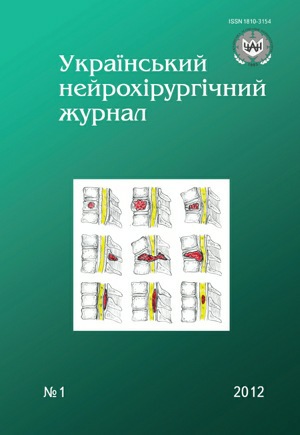Changes in сerebral hemodynamics in patients with severe traumatic brain injury after surgical decompression
DOI:
https://doi.org/10.25305/unj.57745Keywords:
severe traumatic brain injury, brain edema, decompressive craniectomy, intracranial hypertension, transcranial dopplerography, cerebral hemodynamics, pulsatility index, blood flow linear velocityAbstract
A prospective study of 16 patients with severe TBI and traumatic brain edema who had undergone decompressive craniectomy (DC) with dura opening was carried out. Directly before surgical intervention and afterwards, TCDG was used to measure blood flow linear velocity (BFLV) in the middle cerebral artery (MCA) in both hemispheres and in extracranial segments of internal carotid artery (ICA). BFLV increase in MCA and ICA both on the side of surgery and the opposite side was determined. The difference between average BFLV growth in MCA on the side of decompression and the opposite side was statistically significant (P<0.05). MCA and ICA pulsatility index (PI), both on the side of surgery and the opposite side, decreased. PI decrease in MCA was significantly greater on the side of decompression than on the opposite side (P<0.05).
References
1. Gaydar BV, Semenyutin VB, Parfenov VYe, Svistov DV. Transkranialnaya dopplerografiya v neyrokhirurgii [Transcranial Doppler in Neurosurgery]. St. Petersburg: Elbi; 2008. Russian.
2. Bolyukh A. Tserebralnyy vazospazm v hostromu periodi travmatychnoho vnutrishnocherepnoho krovovylyvu [Cerebral vasospasm in acute traumatic intracranial hemorrhage] [dissertation]. Kiev (Ukraine): Romodanov Neurosurgery Institute; 2004. Ukrainian.
3. Morgalla MH, Will BE, Roser F, Tatagiba M. Do long-term results justify decompressive craniectomy after severe traumatic brain injury? J Neurosurg. 2008 Oct;109(4):685-90. [CrossRef] [PubMed]
4. Huang AP, Tu YK, Tsai YH, Chen YS, Hong WC, Yang CC, Kuo LT, Su IC, Huang SH, Huang SJ. Decompressive craniectomy as the primary surgical intervention for hemorrhagic contusion. J Neurotrauma. 2008 Nov;25(11):1347-54. [CrossRef] [PubMed]
5. Rinaldi A, Mangiola A, Anile C, Maira G, Amante P, Ferraresi A. Hemodynamic effects of decompressive craniectomy in cold induced brain oedema. Acta Neurochir Suppl (Wien). 1990;51:394-6. [PubMed]
6. Schaller B, Graf R, Sanada Y, Rosner G, Wienhard K, Heiss WD. Hemodynamic and metabolic effects of decompressive hemicraniectomy in normal brain. An experimental PET-study in cats. Brain Res. 2003 Aug 22;982(1):31-7. [CrossRef] [PubMed]
7. Yamakami I, Yamaura A. Effects of decompressive craniectomy on regional cerebral blood flow in severe head trauma patients. Neurol Med Chir (Tokyo). 1993 Sep;33(9):616-20. [CrossRef] [PubMed]
8. Aaslid R, Markwalder TM, Nornes H. Noninvasive transcranial Doppler ultrasound recording of flow velocity in basal cerebral arteries. J Neurosurg. 1982 Dec;57(6):769-74. [CrossRef] [PubMed]
9. Gosling RG, King DH. Continuous wave ultrasound as an alternative and complement to X-rays in vascular examinations. In: Reneman RE, editor. Cardiovascular application of ultrasound. Amsterdam; 1974. p.266-82.
10. Martin NA, Patwardhan RV, Alexander MJ, Africk CZ, Lee JH, Shalmon E, Hovda DA, Becker DP. Characterization of cerebral hemodynamic phases following severe head trauma: hypoperfusion, hyperemia, and vasospasm. J Neurosurg. 1997 Jul;87(1):9-19. [CrossRef] [PubMed]
11. Stiefel MF, Heuer GG, Smith MJ, Bloom S, Maloney-Wilensky E, Gracias VH, Grady MS, LeRoux PD. Cerebral oxygenation following decompressive hemicraniectomy for the treatment of refractory intracranial hypertension. J Neurosurg. 2004 Aug;101(2):241-7. [CrossRef] [PubMed]
12. Verweij BH, Muizelaar JP, Vinas FC. Hyperacute measurement of intracranial pressure, cerebral perfusion pressure, jugular venous oxygen saturation, and laser Doppler flowmetry, before and during removal of traumatic acute subdural hematoma. J Neurosurg. 2001;95(4):569-72. [CrossRef]
13. Schneider GH, Bardt T, Lanksch WR, Unterberg A. Decompressive craniectomy following traumatic brain injury: ICP, CPP and neurological outcome. Acta Neurochir Suppl. 2002;81:77-9. [PubMed]
14. Hassler W, Steinmetz H, Gawlowski J. Transcranial Doppler ultrasonography in raised intracranial pressure and in intracranial circulatory arrest. J Neurosurg. 1988 May;68(5):745-51. [PubMed]
15. Schmidt B, Czosnyka M, Raabe A, Yahya H, Schwarze JJ, Sackerer D, Sander D, Klingelhöfer J. Adaptive noninvasive assessment of intracranial pressure and cerebral autoregulation. Stroke. 2003 Jan;34(1):84-9. [CrossRef] [PubMed]
16. Juul N, Morris GF, Marshall SB, Marshall LF. Intracranial hypertension and cerebral perfusion pressure: influence on neurologicaldeterioration and outcome in severe head injury. The Executive Committee of the International Selfotel Trial. J Neurosurg. 2000 Jan;92(1):1-6. [CrossRef] [PubMed]
17. Lee JH, Kelly DF, Oertel M, McArthur DL, Glenn TC, Vespa P, Boscardin WJ, Martin NA. Carbon dioxide reactivity, pressure autoregulation, and metabolic suppression reactivity after head injury: a transcranial Doppler study. J Neurosurg. 2001 Aug;95(2):222-32. [CrossRef] [PubMed]
18. Steiner LA, Czosnyka M. Should we measure cerebral blood flow in head-injured patients? Br J Neurosurg. 2002 Oct;16(5):429-39. [CrossRef] [PubMed]
19. Lang EW, Lagopoulos J, Griffith J, Yip K, Mudaliar Y, Mehdorn HM, Dorsch NW. Noninvasive cerebrovascular autoregulation assessment in traumatic brain injury: validation and utility. J Neurotrauma. 2003 Jan;20(1):69-75. [CrossRef] [PubMed]
20. Czosnyka M, Smielewski P, Kirkpatrick P, Laing RJ, Menon D, Pickard JD. Continuous assessment of the cerebral vasomotor reactivity in head injury. Neurosurgery. 1997 Jul;41(1):11-9. [CrossRef] [PubMed]
21. Czosnyka M, Smielewski P, Piechnik S, Steiner LA, Pickard JD. Cerebral autoregulation following head injury. J Neurosurg. 2001 Nov;95(5):756-63. [CrossRef] [PubMed]
Downloads
Published
How to Cite
Issue
Section
License
Copyright (c) 2012 Lyudmila Dzyak, Andriy Sirko, V. Suk, L. Kremenchutska

This work is licensed under a Creative Commons Attribution 4.0 International License.
Ukrainian Neurosurgical Journal abides by the CREATIVE COMMONS copyright rights and permissions for open access journals.
Authors, who are published in this Journal, agree to the following conditions:
1. The authors reserve the right to authorship of the work and pass the first publication right of this work to the Journal under the terms of Creative Commons Attribution License, which allows others to freely distribute the published research with the obligatory reference to the authors of the original work and the first publication of the work in this Journal.
2. The authors have the right to conclude separate supplement agreements that relate to non-exclusive work distribution in the form of which it has been published by the Journal (for example, to upload the work to the online storage of the Journal or publish it as part of a monograph), provided that the reference to the first publication of the work in this Journal is included.









